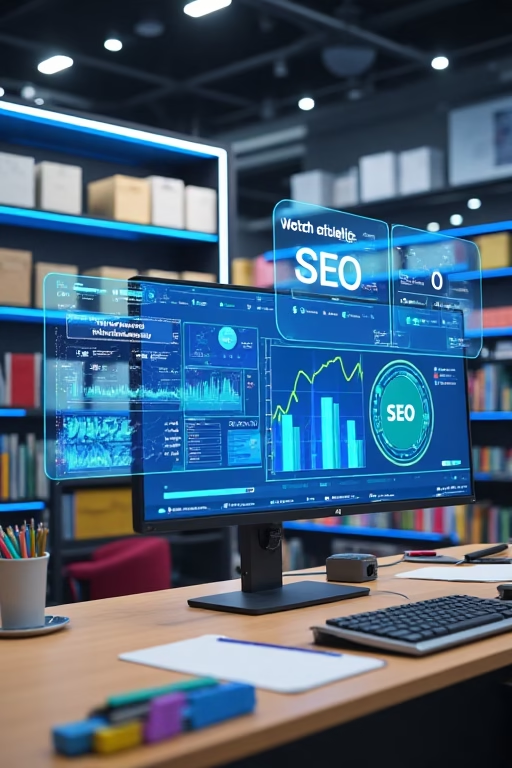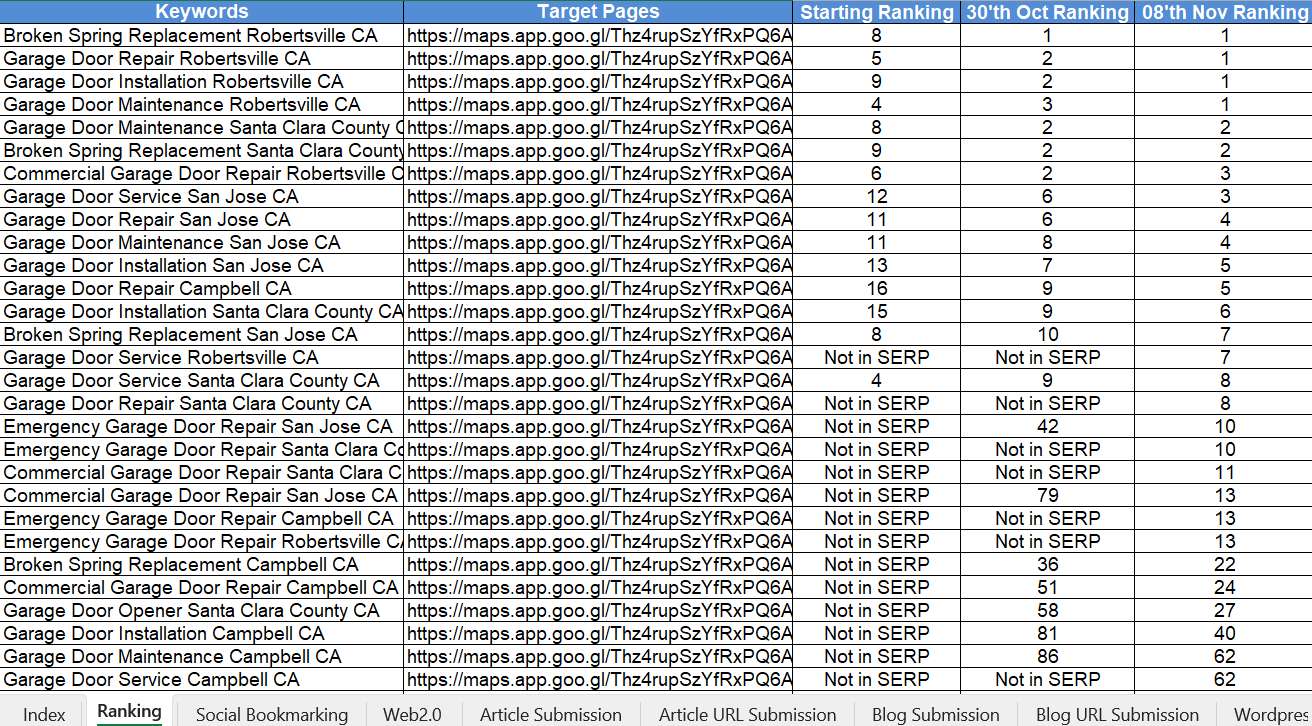Why Digital Ads Work for Selling Tools and Machinery
Why Digital Ads Work for Selling Tools and Machinery
In today's digital age, advertising strategies have evolved dramatically, offering businesses unprecedented opportunities to reach their target audiences with precision and efficiency. For companies involved in selling tools and machinery, leveraging digital ads can be a game-changer. This comprehensive guide explores why digital ads are highly effective for selling tools and machinery, detailing the benefits, strategies, and best practices to maximize your advertising efforts.
Table of Contents
2. Benefits of Digital Ads
Targeted Audience
One of the primary advantages of digital ads is the ability to target specific audiences with precision. Tools like demographic targeting, geographic targeting, and interest-based targeting ensure that your ads reach the right decision-makers who are most likely to be interested in your tools and machinery.
Measurable Results
Digital advertising provides comprehensive analytics and tracking capabilities. You can monitor key metrics such as impressions, clicks, conversions, and ROI in real-time, allowing you to assess the effectiveness of your campaigns and make data-driven decisions to optimize performance.
Cost-Effectiveness
Compared to traditional advertising methods, digital ads often offer more cost-effective solutions. With options like pay-per-click (PPC) and budget-controlled campaigns, you can manage your advertising spend efficiently, ensuring maximum return on investment.
Flexibility and Scale
Digital advertising allows for unparalleled flexibility and scalability. You can quickly adjust your campaigns based on performance, expand to new markets, and experiment with different ad formats and creative approaches to find what works best for your business.
3. Effective Digital Ad Strategies
Pay-Per-Click (PPC)
PPC advertising, particularly through platforms like Google Ads, allows you to bid on keywords relevant to your tools and machinery. When users search for these keywords, your ads appear at the top of the search results, driving targeted traffic to your website.
- Keyword Research: Identify high-intent keywords that potential customers are likely to use when searching for your products.
- Ad Copy Optimization: Create compelling ad copy that highlights the unique features and benefits of your tools and machinery.
- Landing Page Alignment: Ensure that your landing pages are optimized to match the intent of the ads, providing a seamless user experience that encourages conversions.
Display Advertising
Display ads on relevant websites and industry-specific platforms can increase brand visibility and reach a broader audience. Visual ads such as banners, infographics, and rich media can effectively showcase your products and drive engagement.
- Audience Targeting: Use targeting options like contextual targeting and remarketing to reach users who have previously shown interest in your products.
- Creative Design: Invest in high-quality, visually appealing designs that capture attention and convey your brand message clearly.
- Ad Placement: Choose strategic placements on websites and blogs frequented by your target audience to maximize exposure.
Video Marketing
Video content is highly engaging and can effectively demonstrate the functionality and benefits of your tools and machinery. Platforms like YouTube and social media channels are ideal for sharing video ads that capture attention and drive interest.
- Product Demonstrations: Create detailed video demonstrations that showcase how your tools and machinery work in real-world scenarios.
- Customer Testimonials: Share videos of satisfied customers discussing how your products have benefited their businesses.
- Explainer Videos: Develop explainer videos that highlight the unique features and advantages of your products, making it easier for potential customers to understand their value.
Retargeting
Retargeting campaigns allow you to reconnect with users who have previously visited your website but did not make a purchase. By displaying tailored ads to these users, you can remind them of your products and encourage them to return and complete their purchase.
- Dynamic Retargeting: Show specific products that users viewed on your website, increasing the relevance of your ads.
- Frequency Capping: Control the number of times your retargeting ads are shown to avoid ad fatigue and maintain a positive user experience.
- Personalized Offers: Provide special discounts or incentives to entice users to return and finalize their purchase.
4. Platforms for Digital Ads
Google Ads
Google Ads is a versatile platform that allows you to reach users actively searching for tools and machinery through search ads, display ads, and video ads on YouTube. Its extensive targeting options and robust analytics make it a cornerstone of any digital advertising strategy.
- Search Ads: Capture intent-driven traffic by targeting keywords that potential customers use when searching for your products.
- Display Network: Increase brand visibility by placing ads on a vast network of websites relevant to your industry.
- YouTube Ads: Engage users with video ads that demonstrate your products and tell your brand story.
LinkedIn Ads
LinkedIn Ads are particularly effective for B2B marketing, allowing you to target professionals based on job titles, industries, company sizes, and more. This precision ensures that your ads reach the decision-makers who are most likely to purchase your tools and machinery.
- Sponsored Content: Promote your blog posts, case studies, and whitepapers to engage with your professional audience.
- InMail Ads: Send personalized messages directly to the inboxes of your target audience, fostering direct communication.
- Display Ads: Utilize LinkedIn's display ad options to increase brand awareness among specific professional segments.
Facebook and Instagram Ads
Facebook and Instagram offer a wide range of advertising options that can be leveraged to reach a broad audience. These platforms are ideal for showcasing the visual aspects of your tools and machinery through images and videos.
- Carousel Ads: Display multiple products in a single ad, allowing users to swipe through different items.
- Video Ads: Share engaging video content that highlights the features and benefits of your products.
- Lead Generation Ads: Collect lead information directly through ads, simplifying the lead capture process.
YouTube Ads
YouTube Ads are a powerful way to engage with your audience through video content. Whether it's product demonstrations, customer testimonials, or educational content, YouTube provides a platform to showcase your tools and machinery in action.
- TrueView Ads: Allow users to choose whether to watch your video, ensuring that only interested viewers engage with your content.
- Bumper Ads: Short, non-skippable ads that deliver your key message quickly and effectively.
- Sponsored Cards: Display relevant content alongside your videos, driving traffic to your website or product pages.
5. Best Practices
Creative Ad Content
Creating compelling and visually appealing ad content is essential for capturing attention and driving engagement. High-quality images, clear messaging, and strong calls-to-action (CTAs) can significantly enhance the effectiveness of your digital ads.
- High-Quality Visuals: Use professional images and videos that accurately represent your tools and machinery.
- Clear Messaging: Ensure that your ad copy clearly communicates the benefits and features of your products.
- Strong CTAs: Incorporate clear and compelling CTAs that guide users towards the desired action, such as "Learn More," "Request a Demo," or "Buy Now."
Landing Page Optimization
Your landing pages play a crucial role in converting ad traffic into leads and customers. Optimizing these pages for user experience and relevance can significantly improve your conversion rates.
- Consistency: Ensure that the messaging and visuals on your landing pages align with your ads for a seamless user experience.
- Clear Value Proposition: Highlight the unique benefits and features of your tools and machinery prominently on the landing page.
- Easy Navigation: Design landing pages with intuitive navigation and minimal distractions to guide users towards conversion.
- Mobile Optimization: Ensure that your landing pages are fully optimized for mobile devices, providing a smooth experience for all users.
Tracking and Analytics
Implementing robust tracking and analytics is essential for measuring the success of your digital ad campaigns and making informed decisions to optimize performance.
- Conversion Tracking: Set up conversion tracking to monitor the actions users take after clicking on your ads, such as form submissions or purchases.
- Analytics Integration: Integrate your digital ad platforms with analytics tools like Google Analytics to gain comprehensive insights into user behavior and campaign performance.
- Regular Reporting: Generate regular reports to assess the effectiveness of your campaigns, identify trends, and make data-driven adjustments.
A/B Testing
A/B testing involves experimenting with different versions of your ads and landing pages to determine which elements perform best. This iterative approach helps you optimize your campaigns for maximum effectiveness.
- Ad Variations: Test different headlines, images, ad copy, and CTAs to identify the most effective combinations.
- Landing Page Elements: Experiment with different layouts, colors, forms, and content on your landing pages to improve conversion rates.
- Data-Driven Decisions: Use the results from A/B tests to make informed decisions and continuously refine your marketing strategies.
6. Case Studies
Case Study 1: ToolMaster
Overview: ToolMaster is a leading supplier of industrial tools and machinery based in Detroit. Facing intense competition, ToolMaster sought to enhance their digital presence and increase sales through targeted digital advertising campaigns.
Strategies Implemented:
- Comprehensive PPC Campaigns: Launched PPC campaigns targeting high-intent keywords related to industrial tools and machinery.
- Retargeting Efforts: Implemented retargeting campaigns to re-engage visitors who had previously shown interest in their products.
- Video Advertising: Created engaging video ads showcasing product demonstrations and customer testimonials on YouTube.
- Landing Page Optimization: Optimized landing pages to align with ad messaging, improving user experience and conversion rates.
Results:
- Increased Website Traffic: Achieved a 60% increase in website traffic through effective PPC and display advertising.
- Higher Conversion Rates: Improved conversion rates by 25% due to optimized landing pages and targeted retargeting campaigns.
- Enhanced Brand Visibility: Boosted brand awareness through video advertising, resulting in a 40% increase in brand recall among target audiences.
Case Study 2: MachineryPro
Overview: MachineryPro specializes in selling heavy machinery to construction companies across the United States. To expand their market reach and generate qualified leads, MachineryPro invested in a strategic digital advertising campaign.
Strategies Implemented:
- LinkedIn Advertising: Utilized LinkedIn Ads to target procurement managers and decision-makers in the construction industry.
- Content-Driven Ads: Promoted whitepapers and case studies through sponsored content to establish authority and attract leads.
- Social Media Engagement: Engaged with potential clients through interactive social media ads and direct messaging campaigns.
- Analytics and Optimization: Continuously monitored campaign performance and optimized based on data insights to maximize ROI.
Results:
- Lead Generation: Generated a 50% increase in qualified leads through targeted LinkedIn advertising and content-driven campaigns.
- Improved ROI: Achieved a 35% return on investment by optimizing ad spend and focusing on high-performing channels.
- Market Expansion: Successfully expanded into new regional markets, increasing overall sales by 20% within a year.
7. Challenges and Solutions
While digital advertising offers numerous advantages, businesses selling tools and machinery may face specific challenges. Addressing these challenges effectively is crucial for maximizing the success of your digital ad campaigns.
Ad Fatigue
Challenge: Overexposure to the same ads can lead to ad fatigue, where potential customers become disengaged and start ignoring your ads.
Solution:
- Ad Rotation: Regularly rotate your ad creatives to keep your campaigns fresh and engaging.
- Dynamic Ads: Use dynamic ad formats that automatically adjust content based on user behavior and preferences.
- Frequency Capping: Limit the number of times an individual user sees your ads to prevent overexposure.
Budget Management
Challenge: Allocating and managing advertising budgets effectively can be challenging, especially when trying to maximize ROI across multiple channels.
Solution:
- Set Clear Budgets: Define clear budgets for each advertising channel based on their performance and potential ROI.
- Monitor Spending: Use budget tracking tools to monitor ad spend in real-time and make adjustments as needed.
- Allocate Based on Performance: Reallocate budgets to high-performing campaigns and channels to maximize overall effectiveness.
Competitor Oversaturation
Challenge: In highly competitive markets, standing out amidst a sea of competitors' ads can be difficult.
Solution:
- Unique Value Proposition: Clearly communicate your unique selling points that differentiate your tools and machinery from competitors.
- Creative Innovation: Invest in creative and innovative ad formats and designs to capture attention.
- Target Niche Segments: Focus on niche segments within the tools and machinery market to reduce competition and enhance ad relevance.
Tracking Accuracy
Challenge: Ensuring accurate tracking of ad performance and conversions can be complex, especially with multiple platforms and touchpoints.
Solution:
- Unified Tracking Systems: Implement unified tracking systems that integrate data from all advertising platforms for comprehensive analysis.
- UTM Parameters: Use UTM parameters to accurately track the source and performance of each ad campaign.
- Regular Audits: Conduct regular audits of your tracking setups to identify and rectify any discrepancies or issues.
8. Future Trends in Digital Advertising
As technology continues to advance, new trends are emerging in digital advertising that can further enhance the effectiveness of your campaigns. Staying ahead of these trends can provide a competitive edge and drive continued success in selling tools and machinery.
Artificial Intelligence
Artificial Intelligence (AI) is revolutionizing digital advertising by enabling more sophisticated targeting, personalization, and automation. AI-driven tools can analyze vast amounts of data to optimize ad placements, predict user behavior, and personalize ad content in real-time.
- Automated Bidding: AI algorithms can automatically adjust bids based on real-time data to maximize ROI.
- Personalized Content: Deliver personalized ad content tailored to individual user preferences and behaviors.
- Predictive Analytics: Use AI to predict future trends and user actions, allowing for proactive campaign adjustments.
Personalization
Personalization is becoming increasingly important in digital advertising. Tailoring your ads to meet the specific needs and preferences of your target audience can significantly enhance engagement and conversion rates.
- Dynamic Content: Use dynamic ad content that changes based on user data, such as location, browsing history, and device type.
- Behavioral Targeting: Target users based on their online behavior, including past interactions with your website and products.
- Customized Offers: Provide personalized offers and discounts to incentivize conversions.
Interactive Ads
Interactive ads engage users by allowing them to interact with the ad content, leading to higher engagement and better brand recall. Interactive formats can include quizzes, polls, augmented reality (AR) experiences, and interactive videos.
- Quizzes and Polls: Incorporate quizzes and polls to engage users and gather valuable insights into their preferences.
- Augmented Reality: Use AR to allow users to visualize tools and machinery in their own environments, enhancing the decision-making process.
- Interactive Videos: Create videos that require user interaction, such as choosing different product features or navigating through different use cases.
Voice Search Ads
With the rise of voice-activated devices like smart speakers and virtual assistants, voice search is becoming a significant aspect of digital advertising. Optimizing your ads for voice search can help you reach users who prefer using voice commands to search for tools and machinery.
- Conversational Keywords: Incorporate natural language and long-tail keywords that reflect how people speak when using voice search.
- Featured Snippets: Aim to have your content featured in snippets, as these are often used by voice assistants to provide answers.
- Local Optimization: Many voice searches are location-based, so ensure your business information is accurate and optimized for local searches.
9. Conclusion
Digital advertising offers unparalleled opportunities for selling tools and machinery, providing targeted reach, measurable results, and cost-effective solutions. By implementing effective digital ad strategies, leveraging the right platforms, and adhering to best practices, businesses can significantly enhance their marketing efforts and drive substantial sales growth.
Staying abreast of future trends such as artificial intelligence, personalization, interactive ads, and voice search will ensure that your advertising strategies remain relevant and effective in an ever-evolving digital landscape. Embrace these digital advertising strategies to elevate your tools and machinery sales, build stronger customer relationships, and achieve long-term business success.
Frequently Asked Questions (FAQ)
1. Why are digital ads more effective than traditional ads for selling tools and machinery?
Digital ads offer precise targeting, measurable results, and greater flexibility compared to traditional ads. They allow businesses to reach specific audiences, track campaign performance in real-time, and adjust strategies quickly based on data insights, making them more effective for selling tools and machinery.
2. What are the most effective types of digital ads for tools and machinery sales?
The most effective types of digital ads for tools and machinery sales include Pay-Per-Click (PPC) ads, display advertising, social media ads, video marketing, and retargeting campaigns. These formats allow for targeted messaging and engaging visuals that resonate with B2B audiences.
3. How can I measure the success of my digital ad campaigns?
Success can be measured using key performance indicators (KPIs) such as click-through rates (CTR), conversion rates, cost per acquisition (CPA), return on investment (ROI), and overall sales growth. Utilizing analytics tools like Google Analytics and platform-specific dashboards can provide comprehensive insights.
4. What budget should I allocate for digital advertising?
The budget for digital advertising varies based on your business size, goals, and industry competition. It's essential to start with a clear budget plan, allocate funds to high-performing channels, and adjust based on campaign performance and ROI analysis.
5. Can small businesses effectively use digital ads to sell tools and machinery?
Yes, small businesses can effectively use digital ads by focusing on niche targeting, optimizing their ad spend, and leveraging cost-effective platforms like Google Ads and social media. With strategic planning and execution, small businesses can achieve significant results through digital advertising.
6. How important is mobile optimization for digital ads in B2B marketing?
Mobile optimization is crucial as more professionals use mobile devices to research and make purchasing decisions. Ensuring that your ads and landing pages are mobile-friendly enhances user experience, increases engagement, and improves conversion rates.
7. What role does content play in the effectiveness of digital ads?
Content is integral to the effectiveness of digital ads. High-quality, relevant content that addresses the needs and pain points of your target audience can enhance engagement, build trust, and drive conversions. Content marketing also supports SEO efforts, amplifying the reach of your ads.
8. How can I target decision-makers in businesses through digital ads?
Platforms like LinkedIn allow you to target decision-makers based on job titles, industries, company sizes, and other professional criteria. Additionally, using account-based marketing (ABM) strategies and personalized ad content can effectively reach and engage key decision-makers.
9. What are some common mistakes to avoid in digital advertising for B2B sales?
Common mistakes include not defining clear goals, targeting too broadly, neglecting ad and landing page optimization, underutilizing analytics, and failing to test and iterate campaigns. Avoiding these pitfalls can lead to more effective and successful digital advertising efforts.
10. How often should I review and optimize my digital ad campaigns?
It's recommended to review and optimize your digital ad campaigns regularly, ideally on a weekly basis. Continuous monitoring allows you to identify performance trends, make necessary adjustments, and ensure that your campaigns are aligned with your marketing goals and ROI expectations.
25 Additional Keywords for Your Digital Marketing Agency Website
- Digital Advertising Solutions
- Online Marketing Strategies
- SEO Services
- Social Media Management
- Pay-Per-Click Campaigns
- Content Marketing Agency
- Branding and Design
- Email Marketing Services
- Web Development Agency
- Conversion Rate Optimization
- Influencer Marketing
- Video Marketing Services
- Mobile Marketing Solutions
- E-commerce Marketing
- Local SEO Services
- Google Ads Management
- Facebook Advertising Experts
- Digital Strategy Consulting
- Analytics and Reporting
- Reputation Management
- PPC Advertising Agency
- LinkedIn Marketing Services
- Retargeting Campaigns
- Affiliate Marketing Programs
- Creative Marketing Solutions
Why Digital Ads Work for Selling Tools and Machinery Read More »






Social Media Ads
Platforms like LinkedIn, Facebook, and Instagram offer powerful advertising tools tailored for B2B marketing. Social media ads can help you build relationships, engage with your audience, and drive qualified leads.